- Details
- Hits: 1242
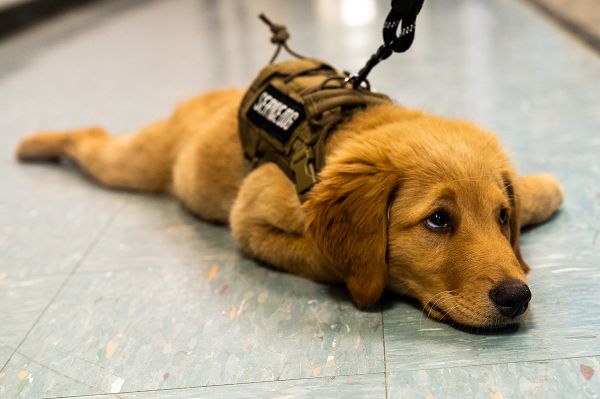
Rosecrans Air National Guard Base, St. Joseph, Missouri. (November 7, 2023): In this photo by Senior Airman Janae Masoner, Koda, the latest support dog for the 139th Airlift Wing, Missouri Air National Guard, poses during a photoshoot while beginning her training as a psychiatric service dog. She is a four-month-old goldendoodle who will assist servicemembers suffering from Post Traumatic Stress Disorder (PTSD) as a therapy and comfort animal. Unlike emotional support animals (ESA), which provide comfort through their presence but require no specialized training, PTSD service dogs are granted specific rights under the Americans with Disabilities Act. These rights include allowing them access to public places where other dogs may be prohibited, such as restaurants, stores, hotels, and on airplanes.
The specialized training these dogs receive helps troops with flashbacks, nightmares, severe anxiety, and uncontrollable thoughts tied to the trauma they suffered.
Typical tasks for PTSD service dogs include waking their handler when they are having nightmares or interrupting flashbacks by responding to signs of stress. These dogs offer comfort during panic attacks and often function as a buffer in crowds to reduce anxiety. They are even trained to intervene to stop self-harming behaviors.
Research has shown these animals help give PTSD sufferers a sense of security and constant companion for twenty-four-hour therapy.
- Details
- Hits: 1288
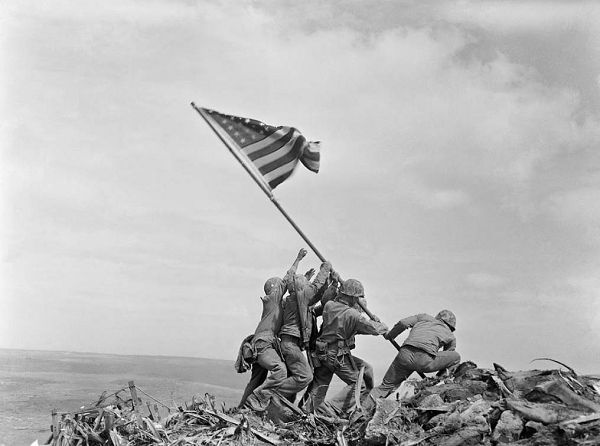
Washington, D.C. (November 7, 2023): This Veteran’s Day, Support Our Troops would like to recognize the service of Native Americans to our national defense. Many Americans may not know that a Native American helped raise old glory on Mount Suribachi on Iwo Jima during World War II. In this iconic Associated Press photo by Joe Rosenthal, Marine Corps PFC Ira Hayes, a 22-year-old Pima Indian from Arizona, helps raise the American flag in an act that saved lives and rallied a nation.
PFC Hayes is on the far left with his hands reaching up toward the flagpole, one of six flag raisers that fateful day. Three of the six were killed on Iwo. A member of the 5th Marine Division, Hayes landed on February 19, 1945, and participated in five days of intense fighting to reach the summit.
Native Americans have served in every U.S. military conflict since the battlefields of the Revolutionary War and have a distinguished record of service. In addition to exploits of PFC Hayes, some four hundred native Navajo “Code Talkers” used their unique, Indigenous language to transmit vital messages on the front lines in the Pacific War. Today nearly nineteen percent of Native Americans have served in all branches of the armed forces, carrying on a 200-year tradition.
Read more: Support Our Troops Celebrates Native American Military Service
- Details
- Hits: 750
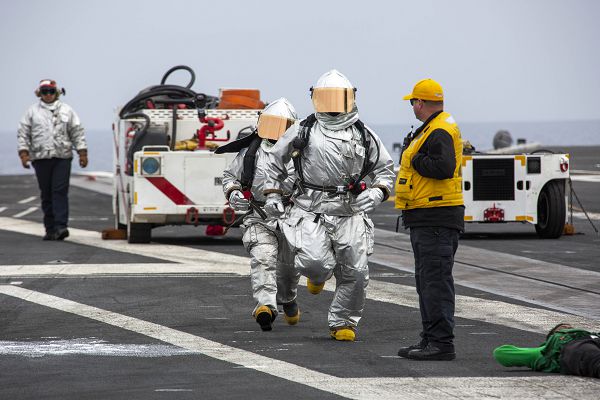
Pacific Ocean. (November 2, 2023): Looking like men from Mars, Aviation Boatswain's Mate (Handling) Airman Jalon English, right, and Aviation Boatswain's Mate (Handling) 3rd Class Roman Grepo race across the flight deck in hazmat suits to rescue a simulated casualty. This photo by MC2 Madison Cassidy captures the chaos Sailors can expect in a mass casualty event during recent drills on the Nimitz-class aircraft carrier USS Abraham Lincoln while underway in the Pacific.
Either through combat or by the dangers inherent to fleet operations, mass casualty incidents are an unfortunate reality for Navy planners. Like their civilian counterparts, the Navy has instituted a triage system to offer the “greatest good to the greatest amount of people” as the ship’s resources will be limited. But unlike civilians, every Sailor on board has a role to play in saving lives during a catastrophic event.
With a crew of 5,600 Sailors and carrying up to 90 aircraft, the USS Abraham Lincoln is like a floating American city at sea. In an emergency, the ship’s doctors, nurses, and corpsmen will be busy setting up triage stations while every Sailor will play a role from donating blood to assisting transporting patients. The term “triage” refers to the preliminary assessment of casualties to determine the urgency of their need for treatment and the nature of the help they need.
- Details
- Hits: 938
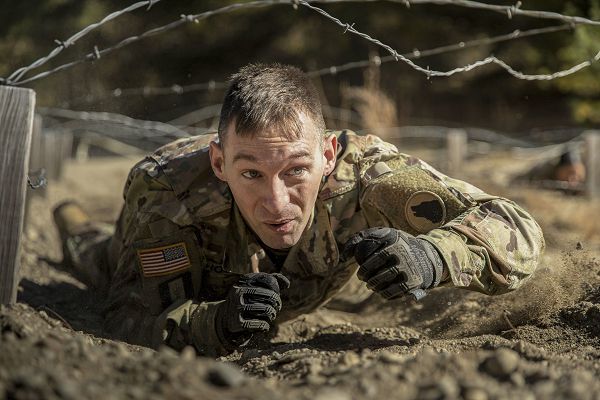
Fort Devens, Massachusetts. (November 1, 2023): In this photo by Sergeant First Class Jeff VanWey, squads from the 3rd Battalion, 304th Regiment compete in the battalion's Wolf Cup Competition, an annual grueling test of their warfighting skills.
The Wolf Cup Competition evaluates a squads’ competencies in basic Army Warrior Tasks including an obstacle course, leader’s reaction course, ruck march, advanced land navigation, and rifle qualification.
The squad is the most basic unit in the infantry and the key to success on the battlefield. Their mission for centuries has been to “locate, close with and destroy the enemy by fire and maneuver, or repel the enemy assault by fire and close combat.” A staff sergeant commands a squad of up to 10 Soldiers and will likely have more sergeants under their leadership. Four squads make up a platoon which has between 20 and 50 soldiers and is commanded by a lieutenant. Two or more platoons make up a company, which has 100 to 250 soldiers and is commanded by a captain or a major.
The squad fights as two fire teams referred to as Alpha and Bravo and made up of at least two automatic riflemen, two marksman, and two grenadiers. A rifleman designated as a marksman is chosen based on demonstrated shooting ability, maturity, good judgement, and ability to execute the full range of infantry duties.
- Details
- Hits: 1049
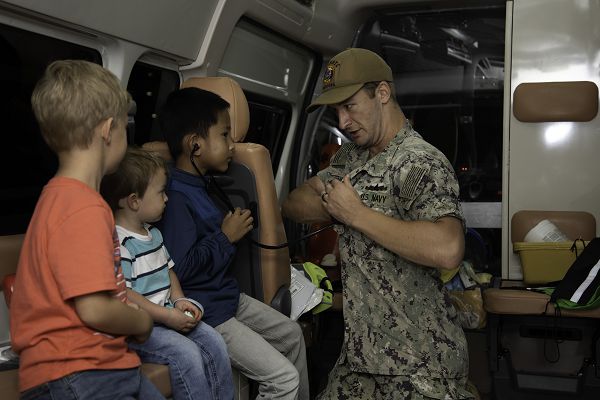
Yokosuka, Japan (Oct. 24, 2023): Since World War II, Japan has hosted thousands of American servicemembers and they have done their best to be good guests. In this photo by Tetsuya Morita, members from Naval Hospital Yokosuka take part in First Responders Tuesday Night Lights, an event to unite the Japanese/American community and to build stronger relationships between local emergency services.
Hosted by Fleet Activities Yokosuka, the Hospital provided an ambulance and other medical equipment to showcase the lifesaving and triage procedures they use to save lives. Under a mutual aid agreement, U.S. military firefighters, police officers, paramedics, and emergency medical technicians collaborate with local authorities to respond to emergencies. For seventy-five years, the U.S. Navy has coordinated these civilian outreach programs to build cooperation and trust with their Japanese hosts.
- Details
- Hits: 993
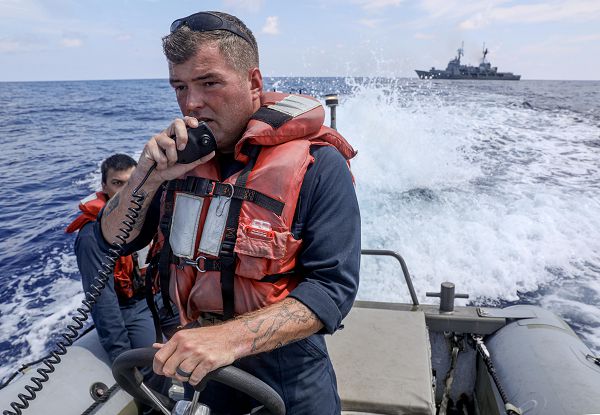
South China Sea. (October 21, 2023): In this photo by MC1 Greg Johnson, Chief Boatswain's Mate Dustin Lewis, from Chattanooga, Tennessee, pilots a rigid-hull inflatable boat after departing the Philippine Navy offshore patrol vessel BRP Gregorio del Pilar. Chief Lewis is assigned to the Arleigh Burke-class guided-missile destroyer USS Dewey which was conducting a joint sailing event in the South China Sea.
The Philippines has become a world hot spot due to increasingly aggressive Chinese naval activity off its coast. Beijing claims sovereignty over nearly the entire South China Sea, an assertion that has been rejected by international courts. The stakes are high for the Philippines as the region is a vital commercial fishing ground while the U.S. sees the waters off its coast as strategically important to projecting military power. China and the Philippines have had several confrontations in the South China Sea recently including a disputed collision between a Chinese coastguard vessel and a boat from the Philippines.


